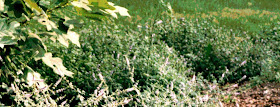Today is National More Herbs, Less Salt Day so I thought this was a great time to remind you of the Backyard Patch Salt-Substitute Grinder Jars and the fact that most of our Herb Mixes and all of our Herb Seasonings are salt-free.
Our classic salt substitute blends with a new "twist." They come in a grinder topped jar. You receive a great combination of flavorful herbs that can grind right into dishes as you cook, or onto a completed meal just like salt or pepper grinders. You also receive the nice long shelf-life associated with Backyard Patch herb blends. These grinders also release the wonderful aroma of the herbs as they work!
- Herby Salt Substitute
- Savory Salt Substitute
- Oniony Salt Substitute
- Spicy Salt Substitute (NEWEST!)
Each Grinder Jar is re-fillable, so you can save the jar and help the environment. They sell for $4.75 with refills priced at $3.50
Get yours today on our website.
Most, but not all of our Herb mixes are salt-free. When you use nice fresh herbs you can eliminate salt and don’t really miss it. So here is a short list of our most popular salt free herb mixes for sauces, dips, cheese spreads and rubs. We thought it might be a bit much to list all 27 salt-free blends, but you can check them all out on our Website.
- NEWEST – Salt-free Lemon Chive Dressing
- Beauy-Monde (a salt-free version of the original Spice Island blend)
- Marcy’s Dill Dip
- Garlic and Herb Combination
- Fiesta Dip
- Boursin Cheese Spread (the Butter N Cheese, Herbal Spread and Cilantro Spread don’t have any salt either)
- Potato Topper
- Lemon-Sage Marinade
- Grilled Meat Rub & 4-Spice Meat Rub
Each of our mixes are available in a zip-seal pouch for just $2.35. You can find them all in this listing on eBay, or individually on our Website.
Herbal Seasonings (Always have been and always will be salt-free!)
Herbal Seasonings are blends of herbs you can shake into any dish or meal. We serve them up in a glass jar ($4.50) or a refill pack ($3.50). They can substitute for a large collection of single herbs by giving you a tasty blends formulated to spice up your cooking with just a shake.
Here is a list of the blends currently available.
DO-IT-ALL Seasoning
Fines HerbesItalian Seasoning
Meat Seasoning
Pickling Spice
Pizza Pie Shaker Blend
Poultry Seasoning
Rainbow Soup Blend SeasoningSeafood Seasoning
Soup & Salad Seasoning
Vegetable Seasoning
All of them can be found in this etsy listing, or individually on our Website.
Have fun and enjoy you National More Herbs, Less Salt Day!
For some recipes to use with Salt Substitute blends, check out this blog post from last August!



















